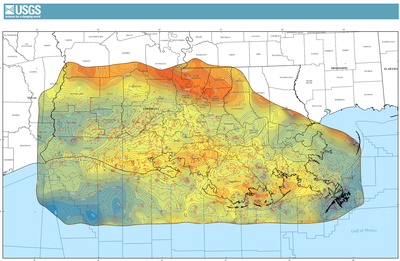Series of Five Maps Characterizing Geopressure Gradients: Southern Louisiana, State and Federal Waters
by Lauri A. Burke, Scott A. Kinney, Russell F. Dubiel, and Janet K. Pitman, US Geological Survey, Denver
This series of five maps characterizes the subsurface pressure system of southern Louisiana, including the associated State and Federal waters. These maps were generated using the U.S. Geological Survey’s (USGS) comprehensive geopressure-gradient model (Burke et al., 2012b, 2013) that delineates the regional pressure system spanning the onshore and offshore Gulf of Mexico basin, USA. Previously, the model was used to generate ten regional-scale maps (Burke et al., 2012a): five contour maps characterized the depth to the surface defined by the first occurrence of regional isopressure gradients ranging from 0.60 psi/ft to 1.00 psi/ft, in 0.10-psi/ft increments; and five supporting maps displayed the spatial density of the data used to construct the regional contour maps. Explanation of generalized geopressure gradients and pressure-regime nomenclature is given here.
The five contour maps in this series characterize the depth to the surface defined by the first occurrence of isopressure gradients ranging from 0.60 psi/ft to 1.00 psi/ft, in 0.10-psi/ft increments. The geographical extent of this geopressure-gradient model is delineated on the maps, which encompass one of the most densely drilled regions of southern Louisiana and adjacent areas. The boundary of the model represents the area of greatest well density to maintain accurate contouring to the edge of the model. The pressure data were obtained from the IHS database (IHS Energy Group, 2011) and geologic folios (Dodge and Posey, 1981; Bebout and Gutiérrez, 1982; 1983; Eversull, 1984; Foote et al., 1990), which were compiled and digitally archived (Burke et al., 2011). Data quality analysis, linear-pressure interpolation calculations, and contouring algorithms defining the geopressure-gradient model are described by Burke et al. (2012b, 2013).
The isopressure-gradient trends depicted on these maps are not intended for detailed interpretation at specific locations.
Click Here to Download File
